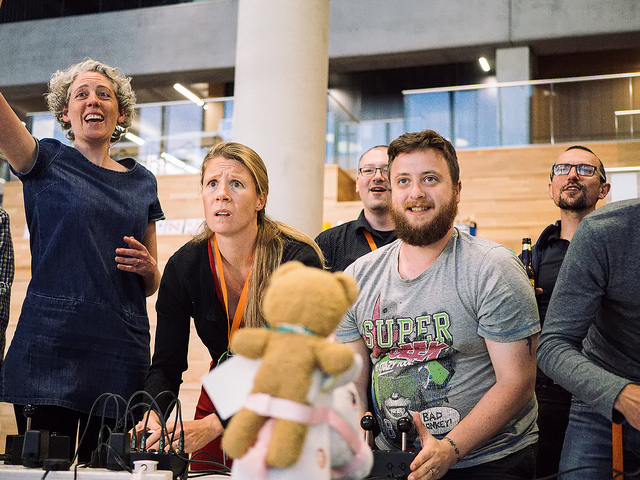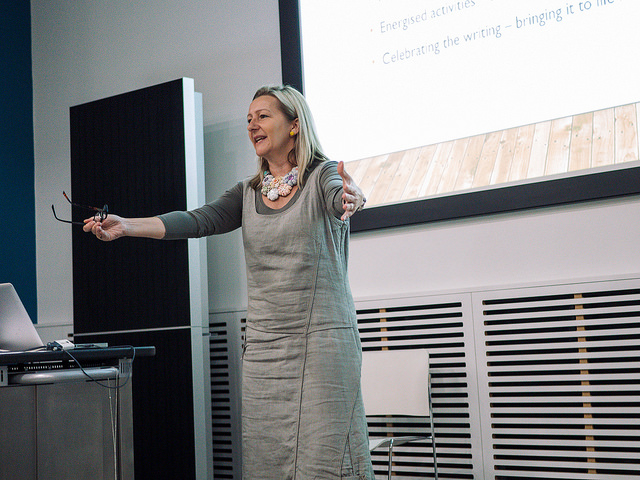I was fortunate enough to attend the Playful Learning conference over the summer. We explored how playfulness can be included in adults’ learning experiences, which involved things such as playing games that were being used in Higher Education, making things, and experiencing escape rooms.
We were all given cuddly toys with which we were to undertake certain activities, to encourage playfulness in the conference. One of the tasks was to create a twitter profile for the toys, and in the end it was pointed out that these toys had ended up acting as avatars for us on the #playlearn17 twitter hashtag, allowing behaviour that might otherwise have been considered odd or bad.
Nikki Woods talked about her work with Blast Theory, and their experiences of the consequences of play. It brought up ideas about how it is important to remember that not everyone knows when ‘play’ is taking place, and that people will perceive it differently.
There were quite a lot of escape rooms, which were fun. They have been used as ice-breakers, or as activities for the students to create themselves.
Escape room detritus at #playlearn17 . Excellent session by @lizcable who has done this with thousands of students as icebreaker. pic.twitter.com/W6Kgpp77rB
— Lib Research Support (@MMU_LRS) July 13, 2017
Geraldine Foley, Sarah Leach, and Aggie Molnar from LSE guided us through playing their ‘Capture the Market’ game. It presented some themes like monopoly and diversification, that could later be discussed. It brought out the tension between learning and gameplay, as some players wanted the game to be more complex and open to mastery through playing it several times, while others thought it was designed well for a game that was only played once to start conversations in the classroom.
Amid all the lego, sandpits, and giant playing cards, Rikke Toft Norgard was exploring the theory of play, how we can encourage play to connect “to the deep structures of pedagogical ‘how to’ designs” and to be “embedded in the virtues emanating from the ‘why-ness’ of education?”, and presenting a framework for a playful university. I recon everyone loved it, and Rikke’s slides are available.
Wonderful keynote from @RikkeToftN #playlearn17 pic.twitter.com/p4FJs73Dk1
— Giskin (@GiskinDay) July 13, 2017
Don't recognise the Turner quote, but really like it... #playlearn17 Spot on for Uni stuff & transformative learning. pic.twitter.com/g743OpIHLo
— Andrew Walsh (@playbrarian) July 13, 2017
I have such an academic crush on @RikkeToftN right now #playlearn17 pic.twitter.com/HYmCJ6EEaU
— AgnestheFurryTurtle (@FurryAgnes) July 13, 2017
Finally we heard from Deborah Bullivant, who set up Grimm & Co in Rotherham. She talked about their amazing work encouraging children to write through creative, playful environments. She talked about similar projects such as London’s Hoxton Street Monster Supplies, San Francisco’s Pirate Supply Store, and Brooklyn’s Superhero Supply co.
I’ve never had more fun at a conference, and it left me with plenty to think about. It is easy to be playful at a conference where it is explicitly expected. It’s unlikely that people attending will get annoyed, or be cynical and not pay along. How is that expectation set out in university? I’ve seen the occasional students say “I’m not doing that” when a session moved away from the standard lecture or seminar format. Is the solution to be clear about the reason for doing things differently?
Playfulness and games are different things, that don’t always overlap. Games can be taken very seriously, and some types of playfulness affect game mechanics in a negative way.
This year’s reading includes:
- Huizinga’s ‘Homo ludens: a study of the play-element in culture’ [EHU link]
- Sicart’s ‘Play Matters’ [EHU link]
You can explore further using #playlearn17 on Twitter, or Alex Mosely’s Storify of the conference days (day 1, day 2, day 3)
All images from:
https://www.flickr.com/photos/144603711@N05/sets/72157686737802183.
Used under a Creative Commons licence.
Peter Beaumont
Learning Technology Development Officer









